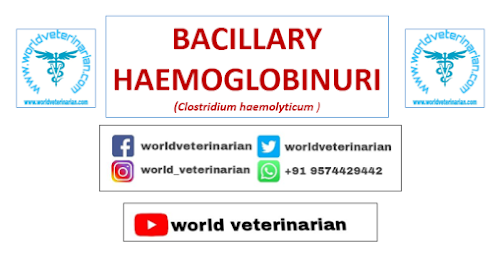Clostridium diseases in animals
1. Black quarter :- Click here
2. Tetanus:- Click here
3. Enterotoxaemia :- Click here
4. Bacillary haemoglobinuria:- Click here
5. Botulism
6. Braxy
7. Infectious Necrotic hepatitis
8. Malignant oedema
Organism | Disease |
Cl. chauvoei | Black quarter/ black leg |
Cl. tetani | Tetanus |
Cl. perfringens | Enterotoxaemia |
Cl. septicum | Braxy, malignant edema (gas agangrene) |
Cl. haemolyticum | Bovine bacillary haemoglobinuria / red water disease |
Cl. novyi | Black disease |
Cl. botulinum | Botulism |
BACILLARY HAEMOGLOBINURIA
⇒ It
is an infectious disease of cattle and sheep characterised by high rise of
temperature, depression, Rapid haemolysis off RBCs, icterus and haemorrhage. It
is a fatal disease and death may occur in 24 to 36 hours.
Synonyms:
⇒ Red water disease
⇒ Infectious haemoglobinuria
DISTRIBUTION
⇒ The
disease has been recorded from US, Australia, New Zealand and Great Britain. The
disease is highly prevalent in those areas where there is preponderance of
faciolosis.
ETIOLOGY
⇒ The
disease is caused by a Clostridium haemolyticum ( cl. Novyi type-D) ,
⇒ It
is a soil borne anaerobic, motile, sporulating, rod having parallel sides and
rounded ends.
⇒ The
spore can persist in soil and water for long time.
⇒ The
Organism can produce potent toxin
that is haemolytic in nature.
⇒ Toxins
are haemolytic and necrotic in
nature.
SUSCEPTIBLE HOSTS
⇒ It is primarily a disease of cattle.
⇒ Cattle of all ages do suffer.
⇒ But the disease has been observed in sheep and dog.
MODE OF TRANSMISSION
⇒ The
transmission depends on the virulence of the Organism and the geographical area
where the spores are discharged.
⇒ Swampy
areas, areas having plenty of rain, falls and irrigation favours the spread of
the disease.
⇒ Spore
can be carried from infective zone to non infective zone through flood and
irrigation.
⇒ The
disease may also spread through transportation of infected tissues, a contaminated
feed and water.
PATHOGENESIS
The
organisms on Ingestion lodge in the intestine and set up duodenitis.
⇓
After penetrating portal blood vessels in the duodenum the organisms are carried to the liver and localize there.
⇓
The
organisms liberate toxins and there is extensive damage of liver and resultant
hypoxia.
⇓
There
is a necrotic changes in the liver.
⇓
The
toxins thus liberated in large amount cause haemolysis.
⇓
The
Rbcs are haemolysed and there is a severe hypoxemia.
⇓
Along
with other metabolic agents, injure capillary and ruthenium, and increase
capillary permeability and thus escape into tissue.
⇓
Oedematous
fluid accumulates in the body cavity.
⇓
Bacteraemia
may develop during the disease process.
⇓
It
has been pointed out that liver fluke infestation acts as conductive agent for
the flaring up of the disease.
CLINICAL FINDINGS
⇒ The animal may be found lying dead without
showing any premonitory signs.
⇒ There is sudden appearance of the disease,
characterised by…
⇒ High rise of temperature
⇒ Reduced appetite
⇒ Depression
⇒ Suspension of rumination
⇒ Defecation
⇒ Fall in milk yield
⇒ Arc back condition.
⇒ Reluctance in movement,
⇒ Dry muzzle
⇒ Rapid pulse evidence of jugular pulse and red
colour urine.
⇒ The visible mucus membranes of mouth eye and
vagina are pale and icteric.
⇒ Death is due to Toxaemia and hypoxemia.
⇒ Hypoxemia is due to destruction of RBC.
DIAGNOSIS
· ⇒ Clinical signs – haemolysis and haemoglobinuria
· ⇒ CBC – Low RBC count and low Hb.
· ⇒ Lesion – pathognomonic liver infarction
· ⇒ Isolation of organism through culture
· ⇒ Serum agglutination test
· ⇒ F.A.T.
DIFFRENTIAL DIAGNOSIS
1. ⇒ Leptospirosis
2. ⇒ Anaplasmosis
3. ⇒ Babesiosis
4. ⇒ Post parturient haemoglobinuria
5. ⇒ Enzootic haematuria
6. ⇒ Myoglobinuria
TREATMENT
⇒ It
is very highly fatal for acute disease.
⇒Therefore,
prompt treatment is required for effective response.
⇒ Antibiotics
like penicillin or tetracycline are to be used at a large doses at 12 hours interval.
⇒ Antiserum
may be given at a dose rate of 500 to
1000 ml Depending on body weight.

Post a Comment